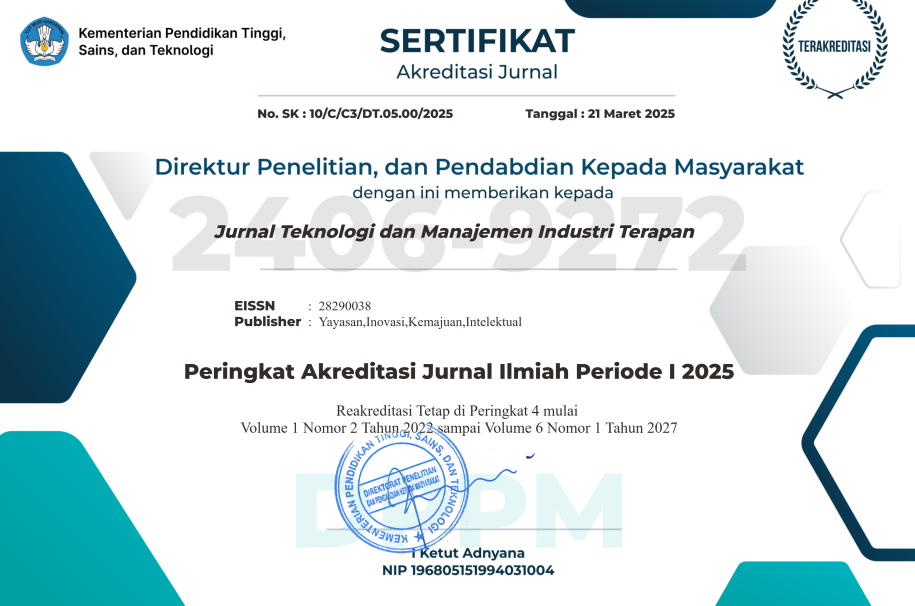The Influence of Servicescape on Travel Decisions with Customer Satisfaction as a Moderating Variable
DOI:
https://doi.org/10.55826/jtmit.v4iI.1002Keywords:
Servicescape, Travel Decisions, Customer SatisfactionAbstract
This quantitative study uses an explanatory approach emphasizing basic research to compile arguments systematically and according to applicable scientific rules. The data used in this study are primary data that researchers obtained from tourists to Java S Beach, Beaches in Bali, and Beaches in Lampung, totaling two hundred and eighty-five foreign and local tourists. The data obtained by researchers were analyzed using the smart PLS 4.0 analysis tool. The result in this article shows that all hypotheses in this study can be accepted and proven. In the first hypothesis, the Serviceescape variable can have a positive relationship direction and a significant influence on Travel/Visit Decisions at a tourist attraction because the P-values are positive and below the 0.05 significance level, namely 0.013. This indicates that better Serviceescape implementation at a tourist attraction can make tourists more comfortable and interested, and help them decide to visit. In the following hypothesis, the Customer Satisfaction variable can strengthen the influence of the Serviceescape variable on Visit Decisions. The P-values are positive and below the 0.05 significance level, 0.000. Thus, it can be concluded that this article's first and second hypotheses are acceptable.
References
R. Yunita, “Pengaruh Servicescape Dan Kualitas Layanan Terhadap Kepuasan Konsumen Dan Dampaknya Terhadap Word Of Mouth (Studi Kasus : Post Shop Coffee Tofee Di Kota Bogor),” J. Ilm. Akunt. Dan Keuang., Vol. 4, No. 1, 2021.
K. Namasivayam, The Servicescape, Vol. 3, No. 1. Jakarta: Handbook Of Hospitality Operations And It, 2008.
K. A. Hasibuan, “The Influence Of Price, Word Of Mouth And Servicescape On Consumer Purchasing Decisions At Ayos Coffe Rantauprapat Café Pengaruh Harga, Word Of Mouth Dan Servicescape Terhadap Keputusan Pembelian Konsumen Pada Café Ayos Coffe Rantauprapat,” Manag. Stud. Entrep. J., Vol. 4, No. 2, P. 16, 2023.
W. R. Situmorang, “The Effect Of Social Media, Servicescape And Customer Experience On Revisit Intention With The Visitor Satisfaction As An Intervening Variables In The Tree House On Tourism Habitat Pamah Semelir Langkat Regency,” Int. J. Res. Rev., Vol. 7, No. 2, P. 79, 2020.
P. K. Keller, Marketing Managemen (I. Pearson Education (Ed.). Pearson Education Limited, 2016.
P. T. Kotler, Manajemen Pemasaran. Jilid Iiedisi Ketiga Belas.B. Sabran (Trans.). Jakarta: Erlangga, 2017.
P. Kotler, Prinsip-Prinsip Pemasaran. Diterjemahankan Oleh Bob Sabran. Ed. 12 Jd. 1. Jakarta: Erlangga, 2008.
P. Kotler, Manajemen Pemasaran. Diterjemahankan Oleh Bob Sabran. Ed. 13 Jd. 2. Jakarta: Erlangga, 2009.
R. Komalasari, P. Pramesti, And B. Harto, “Teknologi Informasi E-Tourism Sebagai Strategi Digital Marketing Pariwisata,” Altasia J. Pariwisata Indones., Vol. 2, No. 2, Pp. 163–170, 2020, Doi: 10.37253/Altasia.V2i2.559.
K. Khotimah, “( Studi Kasus Pada Kawasan Situs Trowulan Sebagai Pariwisata Budaya Unggulan Di Kabupaten Mojokerto ),” Vol. 41, No. 1, Pp. 56–65, 2017.
W. D. Ramadhan, “Analisa Slum Tourism Sebagai Alat Propaganda Pariwisata Indonesia (Studi Kasus : Provinsi Dki Jakarta Tahun 2008-2016),” Indep. (Journal Econ., Vol. 4, No. 2, Pp. 1–23, 2016.
K. Philip, Manajemen Pemasaran: Analisis Perencanaan Implementasi Dan Pengendalian. Jakarta: Gramedia Pustaka Utama, 2013.
Lupiyoadi, Manajemen Pemasaran Jasa. Jakarta: Salemba Empat, 2014.
A. Thamrin, Manajemen Pemasaran. Jakarta: Raja Grafindo Persada, 2013.
K. Philip, Manajemen Pemasaran Analisis Perencanaan, Implementasi Dan Pengendalian. Jakarta: Erlangga, 2015.
I. Gitosudarmo, Manajemen Pemasaran. Yogyakarta: Bpfe, 2000.
Danang Alif Fandy, “Pengaruh Servicescape Dan Service Quality Terhadap Customer Satisfaction Pada The Cups & Co Cabang Iskandar Muda,” Universitas Medan Area Medan, 2025.
S. P. Ningsih, “Pengaruh Servicescape, E- Wom (Electronic Word Of Mouth), Dan Promosi Terhadap Keputusan Berkunjung Pada Obyek Wisata Alam Goa Lawa Kabupaten Purbalingga,” Universitas Islam Negeri (Uin) Prof. K.H. Saifuddin Zuhri Purwokerto, 2025.
R. F. Silalahi, “Pengaruh Servicescape, Lokasi Dan Promosi Terhadap Keputusan Pembelian Pada Café Richeese Factory Rantauprapat. Journal Of Economic, Bussines And Accounting (Costing),” J. Econ. Bussines Account., Vol. 7, No. 1, P. 2308, 2023.
S. Abdurahman, Metodologi Penelitian. Jakarta: Sinar Grafika, 2016.
Sugiyono, Metode Penelitian Kuantitatif, Kualitatif, R&D. 2019.
Jonathan Sarwono, Meode Penelitian Kualitatif Dan Kuantitatif. Bandung: Graha Ilmu, 2016.
I. Ghozali, Aplikasi Analisis Multivariete Dengan Program (Ibm. Spss). Diponergoro: Univrsitas Dipenogoro, 2016.
M. Sarstedt, C. M. Ringle, D. Smith, R. Reams, And J. F. Hair Jr, “Partial Least Squares Structural Equation Modeling (Pls-Sem): A Useful Tool For Family Business Researchers,” J. Fam. Bus. Strateg., Vol. 5, No. 1, Pp. 105–115, Mar. 2014.
Hair, Multivariate Data Analysis, Seventh Editions. Prentice Hall: New Jersey, 2010.
Downloads
Published
Issue
Section
License
Copyright (c) 2025 Eva Desembrianita, Agus Sunatha Putra, Muhammad Fikri Maulana, Heppi Syofya, Julinta Paulina

This work is licensed under a Creative Commons Attribution-NonCommercial-ShareAlike 4.0 International License.


















